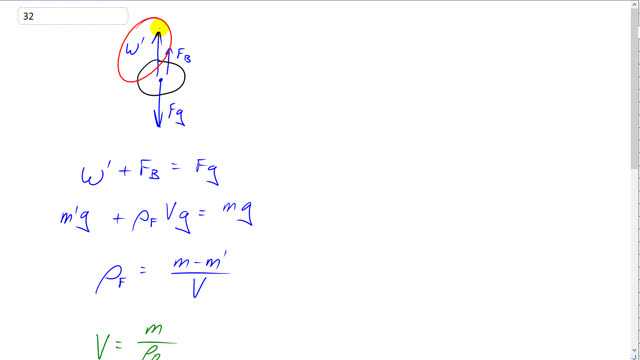
Archimedes’ principle can be used to determine the specific gravity of a solid using a known liquid (Example 10–8). The reverse can be done as well.
- As an example, a 3.80-kg aluminum ball has an apparent mass of 2.10 kg when submerged in a particular liquid: calculate the density of the liquid.
- Determine a formula for finding the density of a liquid using this procedure.

In order to watch this solution you need to have a subscription.
This is Giancoli Answers with Mr. Dychko. When an object is submerged into fluid, it experiences two forces upwards: one being the buoyant force exerted by the fluid; and the other being the spring scale force upwards— this is the apparent weight, W prime— and downwards: we have the force of gravity and the total up equals the total down since this object is just suspended in the fluid and it's not moving. So the apparent weight is the apparent mass times g and the buoyant force of the fluid is the mass of fluid displaced times g so that's the weight of the fluid displaced in other words that is the density of fluid times the volume of fluid displaced and since this object is submerged, the fluid volume displaced equals the volume of the object and that equals the true mass of the object measured in a vacuum times g. So we can solve for the density of the fluid by canceling g everywhere and then bring this m prime to the right side and then afterwards divide by v. So density of fluid is true mass minus the apparent mass divided by the volume of the object. So it doesn't quite solve things for us because we don't know the volume of the object but we can express it as the mass of the object divided by the object's density— aluminum in this case— and then substitute that into here in this line. Now instead of dividing by a fraction, we are gonna multiply by its reciprocal because that's easier to look at. So we have multiplied by density of the object divided by its true mass. So here's a formula for the density of the fluid then density of the fluid is the object's density that we are putting into the fluid times by the object's true mass minus the apparent mass divided by its true mass. So... well, we are dealing with aluminum here... we have 2.70 times 10 to the 3 kilograms per cubic meter times 3.80 kilograms—true mass— minus 2.10 kilograms—apparent mass— divided by 3.80 gives 1.21 times 10 to the 3 kilograms per cubic meter must be the density of this fluid.